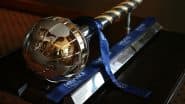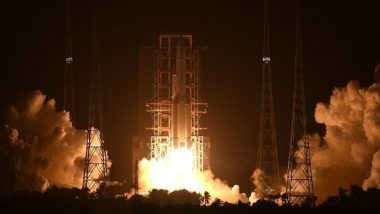Beijing December 6: China's Chang'e-5 probe that touched down on the moon transferred the rock samples it collected from the lunar surface to its orbiter on Sunday, with an ambitious aim to bring them back to Earth for the first time in nearly 45 years, the country's space agency said.
Chang'e-5 probe, comprising an orbiter, a lander, an ascender, and a returner, was launched on November 24, and its lander-ascender combination touched down on the north of the Mons Rumker in Oceanus Procellarum, also known as the Ocean of Storms, on the near side of the moon on December 1. China Hoists Its Flag on Moon Before Chang'e-5 Spacecraft's Take-Off, See Picture.
The ascender of the spacecraft which collected samples from the moon successfully rendezvoused and docked with the orbiter-returner combination in lunar orbit early Sunday, the China National Space Administration (CNSA) said.
Next, the orbiter-returner will separate from the ascender, and wait for the right time to return to Earth, it said. The samples collected on the moon had been transferred from the ascender to the returner safely by 6:12 am (local time), said the CNSA.
After the samples were collected and sealed, the ascender of Chang'e-5 took off from the lunar surface on December 3. The Chang'e-5 probe, named after the mythical Chinese moon goddess, is expected to bring about 2 kilogrammes of lunar samples back to Earth.
China chose a complicated technological approach, including unmanned rendezvous and docking in lunar orbit, in order to bring back more samples and lay a technological foundation for manned lunar missions, said Pei Zhaoyu, deputy director of the Lunar Exploration and Space Program Centre of the CNSA.
This is the first-time a Chinese spacecraft has carried out rendezvous and docking in lunar orbit. Chang'e-5 is one of the most complicated and challenging missions in Chinese aerospace history, as well as the world's first moon-sample mission in more than 40 years.
Those samples will now be put in a return capsule for the trip home, expected to land in Inner Mongolia later this month. If the mission is successful, it will make China only the third country to return samples from the moon, more than 50 years after the US Apollo missions.
The last successful lunar sample return mission was the Soviet Union's Luna 24 mission in 1976. Beijing is looking to match its rivals' - the US and Russia - achivements and has poured billions into its military-run space programme.













 Quickly
Quickly












